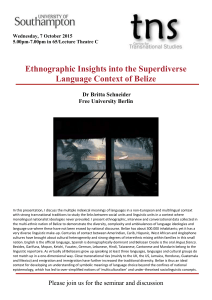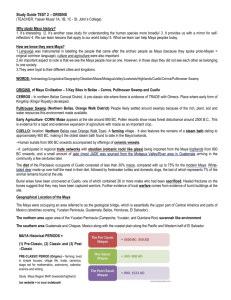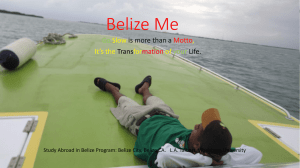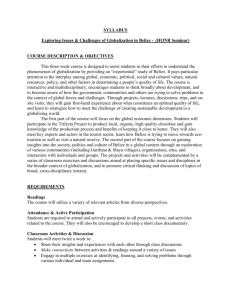Aurelio Cal and Maya Village of Santa Cruz v. Basilio Teul et al, the
advertisement
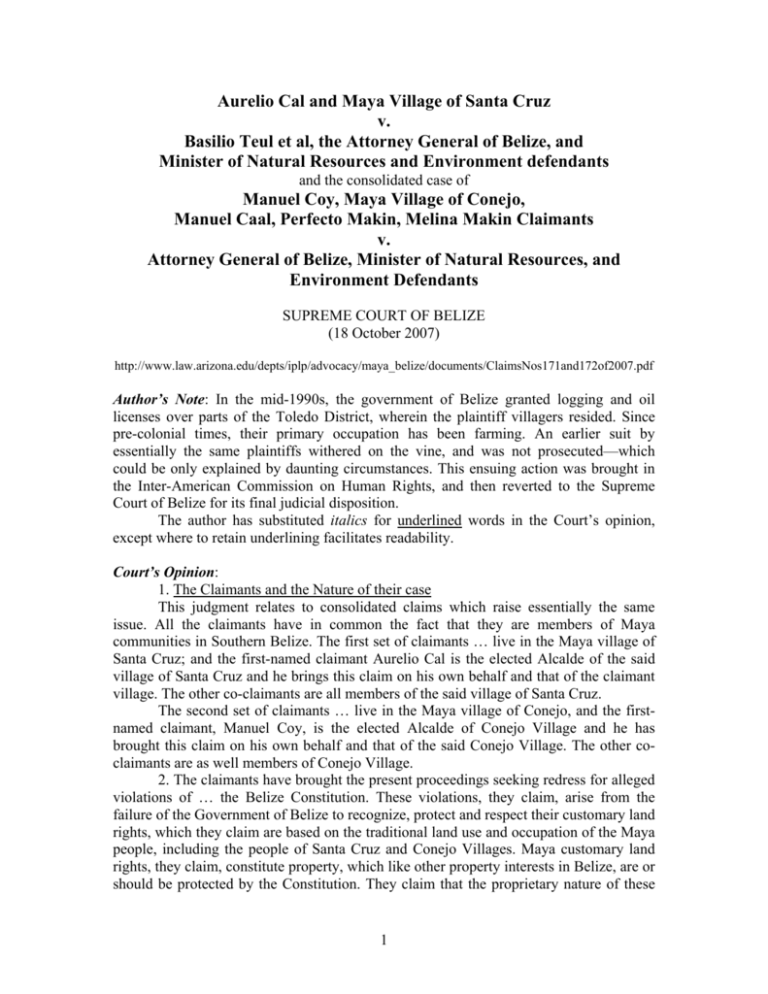
Aurelio Cal and Maya Village of Santa Cruz v. Basilio Teul et al, the Attorney General of Belize, and Minister of Natural Resources and Environment defendants and the consolidated case of Manuel Coy, Maya Village of Conejo, Manuel Caal, Perfecto Makin, Melina Makin Claimants v. Attorney General of Belize, Minister of Natural Resources, and Environment Defendants SUPREME COURT OF BELIZE (18 October 2007) http://www.law.arizona.edu/depts/iplp/advocacy/maya_belize/documents/ClaimsNos171and172of2007.pdf Author’s Note: In the mid-1990s, the government of Belize granted logging and oil licenses over parts of the Toledo District, wherein the plaintiff villagers resided. Since pre-colonial times, their primary occupation has been farming. An earlier suit by essentially the same plaintiffs withered on the vine, and was not prosecuted—which could be only explained by daunting circumstances. This ensuing action was brought in the Inter-American Commission on Human Rights, and then reverted to the Supreme Court of Belize for its final judicial disposition. The author has substituted italics for underlined words in the Court’s opinion, except where to retain underlining facilitates readability. Court’s Opinion: 1. The Claimants and the Nature of their case This judgment relates to consolidated claims which raise essentially the same issue. All the claimants have in common the fact that they are members of Maya communities in Southern Belize. The first set of claimants … live in the Maya village of Santa Cruz; and the first-named claimant Aurelio Cal is the elected Alcalde of the said village of Santa Cruz and he brings this claim on his own behalf and that of the claimant village. The other co-claimants are all members of the said village of Santa Cruz. The second set of claimants … live in the Maya village of Conejo, and the firstnamed claimant, Manuel Coy, is the elected Alcalde of Conejo Village and he has brought this claim on his own behalf and that of the said Conejo Village. The other coclaimants are as well members of Conejo Village. 2. The claimants have brought the present proceedings seeking redress for alleged violations of … the Belize Constitution. These violations, they claim, arise from the failure of the Government of Belize to recognize, protect and respect their customary land rights, which they claim are based on the traditional land use and occupation of the Maya people, including the people of Santa Cruz and Conejo Villages. Maya customary land rights, they claim, constitute property, which like other property interests in Belize, are or should be protected by the Constitution. They claim that the proprietary nature of these 1 rights are affirmed by Maya customary law, international human rights law and the common law. In particular, they claim that the customary land rights of the Maya people of Belize, including the claimants, have been recognized and affirmed as property by the Inter-American Commission on Human Rights in the case of the Maya Indigenous Communities of the Toledo District v Belize. (More on this later.) 3. The claimants allege as well that the Government of Belie has consistently failed to recognize and protect their property rights in the lands they and their ancestors have traditionally used and occupied; and that this failure to accord the same legal recognition and protection to Maya customary property rights unlike that extended to other forms of property is discriminatory and a violation of sections 3 and 16 of the Belize Constitution. ... 6. All the claimants further claim that the government, in particular, the Ministry of Natural Resources and Environment, have issued or threaten to issue leases, grants and concessions to these lands without respecting the traditional land tenure of Santa Cruz and Conejo. ... 8. Finally the claimants claim that the Maya people live, farm, hunt and fish; collect medicinal plants, construction materials and other forest resources; and engage in ceremonies and other activities on land within and around their communities; and that these practices have evolved over centuries from patterns of land use and occupancy of the Maya people. They claim that the property rights that arise from these customary practices are critical to their physical and cultural survival. 9. The claimants therefore now seek the following relief by these proceedings, from this court: a) A declaration that the claimants Villages of Santa Cruz and Conejo and their members hold, respectively, collective and individual rights in the lands and resources that they have used and occupied according to Maya customary practices and that these rights constitute “property” within the meaning of sections 3(d) and 17 of the Belize Constitution. b) A declaration that the Maya Villages of Santa Cruz and Conejo hold collective title to the lands its members have traditionally used and occupied within the boundaries established through Maya customary practices; and that this collective title includes the derivative individual rights and interests of Village members which are in accordance with and subject to Santa Cruz and Conejo and Maya customary law. c) An order that the government determine, demarcate and provide official documentation of Santa Cruz’s and Conejo’s title and rights in accordance with Maya customary law and practices, without prejudice to the rights of neighboring Villages. d) An order that the defendant cease and abstain from any acts that might lead the agents of the government itself, or third parties acting with its acquiescence or its tolerance, to affect the existence, value, use or enjoyment of the property located in the geographic area occupied and used by the Maya people of Santa Cruz and Conejo unless such acts are pursuant to their informed consent and in compliance with the safeguards of the Belize Constitution. This order should include, but not be limited to, directing the government to abstain from: 2 i. issuing any lease or grants to lands or resources under the National Lands Act or any other Act; ii. registering any interest in land; iii. issuing any regulations concerning land or resources use; and iv. issuing any concessions for resource exploitation and harvesting, including concessions, permits or contracts authorizing logging, prospecting or exploration, mining or similar activity under the Forest Act, the Mines and Minerals Act, the Petroleum Act, or any other Act. ... 13. The Evidence ... 17. Undaunted, and not getting a satisfactory response to their claims from the Courts in Belize, the Toledo Maya Cultural Council on behalf of the Maya Indigenous Communities of the Toledo District, launched on 7th August 1998, a Petition to the InterAmerican Commission on Human Rights. ... 19. The Inter-American Commission on Human Rights delivered its Report … on the merits, on 12th October 2004. 20. The defendants have, however, in the written submissions of their learned attorney, taken exception to this Report [which is] in her words: The court cannot merely adopt any findings of facts and law made in another case unrelated to any alleged breach of the provisions of the Constitution. The petition to the Commission related to alleged violations of Articles I, II, III, VI, XI, XVIII, XX and XXIII of the American Declaration of the Rights and Duties of Man, which is an international treaty. If the court were to simply adopt the findings of the Commission without nothing more (sic) that would result in the court enforcing an international treaty and would clearly fall within the bounds of nonjusticiability. 21. Of course, the present proceedings are not a claim to enforce the findings of the Inter-American Commission on Human Rights in that case. The present proceedings rather concern claims relating to alleged breaches of some human rights provisions of the Belize Constitution and for certain declaratory relief and orders. However, the Inter-American Commission on Human Rights is the regional body charged with promoting and advancing human rights in the region and monitoring states compliance with their legal commitments under the Charter of the Organization of American States (OAS). Belize, as a member of the OAS, is therefore a party to the American Declaration of the Rights and Duties of Man, which as Ms. Cho correctly noted, is an international treaty. And this treaty is within the proper remit of the Commission. 22. I am therefore of the considered view that much as the findings, conclusions and pronouncements of the Commission may not bind this court, I can hardly be oblivious to them: and may even find these, where appropriate and co- 3 gent, to be persuasive. ... 24. The defendants on the other hand resolutely deny that the claimants have any customary title to the lands they claim because they (that is, the claimants) are: a) “unable to prove the common law requirements for proofs of aboriginal/native/indigenous title to land, that is, that their forebears were in exclusive, continuous occupation of Southern Belize, including Conejo and Santa Cruz, at the time of British sovereignty;” and that b) “the claimants are unable to prove that they possess any title to land under a traditional law and custom acknowledge by Maya people—that is the Alcalde system.” 25. In my view, I think it is salutary to bear in mind in determining the existence vel non of customary tenure or title to land, the caution sounded by Viscount Haldane in the Privy Council in the case of Amodu Tijani v The Secretary, Southern Nigeria (1921) 2 AC 399: … in interpreting the native title to land, not only in Southern Nigeria, but other parts of the British Empire, much caution is essential. There is a tendency, operating at time unconsciously, to render title conceptually in terms only to systems which have grown up under English law. But this tendency has to be held in check closely. Their Lordships in the Tijani case went on to state that: In India, as in Southern Nigeria, there is yet another feature of the fundamental nature of the title to land which must be borne in mind. The title, such as it is, may not be that of the individual … it nearly always is in some form, but may be that of a community. Such a community may have the possessory title to the common enjoyment of a usufruct, with customs under which its individual members are admitted to enjoyment, and even to a right of transmitting the individual enjoyment as members by assignment inter vivos or succession. To ascertain how far this latter development of right has progressed involves the study of the history of the particular community and its usages in each case. Abstract principles fashioned a priori are of but little assistance, and are as often as not misleading. (Emphasis added [by the Court]). ... 27. The defendants for their part, relied only on the affidavits of public officials, none of whom, with respect, could claim any expertise in Maya history, culture, sociology or land usage and custom. While there is some grudging recognition of “the right of persons to land they have occupied for years undisturbed (in the case of national lands, for a period of 30 years), and that persons of Mayan descent in the Toledo District may qualify as such” (paragraph 9 of Mr. Ismael Fabro’s first Affidavit), the defendants, however, resolutely deny the claimants’ entitlement, as Mr. Fabro continues in the same paragraph as follows: 4 … the Government does not agree that the entire Mayan population of southern Belize living in the communities shown in the Maya Atlas or any other community qualify as such. Most importantly, the Government does not agree that the Mayan population or any part thereof of southern Belize has “native title” to the lands being claimed in the Maya Atlas as the Maya Homeland. Mr. Fabro then exhibited to his affidavit copies of various history books on the ancient Maya and the Maya people of today, including those living in Belize. I find however, that nowhere in the texts relied upon, any statement or assertion of the nonexistence of Maya customary land tenure in southern Belize. ... 40. On the state of the evidence in this case [presented, in detail, by a number of academic experts from the U.S.], I am, therefore, ineluctably bound to conclude that there does exist in the Toledo District Maya customary land tenure. This conclusion, I must say, is supported by the overwhelming evidence of persons with relevant knowledge and expertise of the area and the regime of land tenure there. I have at some length tried to state this evidence in this judgment. 41. I am therefore satisfied that on the evidence, the claimants have established that there is in existence in Southern Belize in the Toledo District, particularly in the villages of Santa Cruz and Conejo, Maya customary land tenure. 42. I am fortified in this conclusion by the finding of the Inter-American Commission on Human Rights in the Maya Indigenous Communities case supra when it stated at paragraph 127 of its Report: 127. Based upon the arguments and evidence before it, the Commission is satisfied that the Mopan and Ke’kchi Maya people have demonstrated a communal property right to the lands that they currently inhabit in the Toledo District. These rights have arisen from the longstanding use and occupancy of the territory by the Maya people, which the parties have agreed pre-dated European colonization, and have extended to the use of the land and its resources for purposes relating to the physical and cultural survival of the Maya communities. 43. Like the Commission in that case, I am satisfied that the defendants in the present proceedings, have not presented any credible argument or evidence to refute the claimants’ argument and evidence concerning the land use patterns practiced by the Maya People in the Toledo District or the customary land tenure system that seems to have been developed by them—see para. 128 of the Commission’s Report ibid. ... 69. The core and nature of the Defence Although the parties agreed on issues the determination of which would strictly be the remit of this judgment, in fairness to the defendants I must state the heart of their case as far as I understand it. From the amended Defence, which as I have already remarked, was done under prompting from the Court and rather late, the testimony from the defence witnesses’ (all by affidavits), the only oral testimony for the defendants was by Mr. 5 Munoz of the Government Press Office who put in evidence a silent video of some Maya Villages not including the two villages in the Toledo District in this case, and the submission, both oral and written, by Ms. Nichola Cho, the learned attorney for the defendants, they seemed to have pitched their tent against the claimants on the principal ground of British sovereignty over British Honduras. This historical fact forms the central plank of the defence. By this historical fact, the argument runs, any claim or title to land the claimants might have had was extinguished by virtue of British sovereignty over the territory. Belize became independent, of course, on 21st September 1981 and its independent governments succeeded to the sovereignty that had belonged to the British Crown. This sovereignty, the argument further runs, was evidenced and consolidated by, as far land and title thereto was concerned, by the series of Crown Lands Ordinances. The defendants put in evidence copies of some of these Ordinances. The Crown Lands Ordinance 1886 was eventually repealed and replaced by the National Lands Act in 1992. ... 76. Did change in or acquisition of territorial sovereignty extinguish pre-existing rights and interests in the land? Did the acquisition of sovereignty over the territory of what is today the independent state of Belize, first by the Crown and later by the successive independent governments (including the defendants) overwhelm or eradicate any interests in or rights to land that the Maya people might have had? As I have found in paras. 61 to 63 above, there was long-standing Maya presence in Southern Belize well before and after the acquisition of sovereignty over the area by the Crown and later by the independent state of Belize. ... 77. I have given deep and anxious consideration to this aspect of this case. I am, however, convinced and fortified by authorities that the acquisition of sovereignty over Belize, first by the Crown and later, by independent governments, did not displace, discharge or extinguish pre-existing interests in and rights to land. The mere acquisition or change of sovereignty did not in and of itself extinguish pre-existing title to or interests in the land. ... 79. From the evidence, it is manifest that throughout the unfolding drama regarding the territory, first, between Spain and later Guatemala on the one hand, and the British authorities on the other, the Maya people were all the while living on their land. There was some forced removal of some of the Maya people by Spanish authorities from some parts of the land; but the fact remains that they were never wholly removed so as to make the land terra nullius [textbook § 6.1.C.] rendering it ownerless or unoccupied. The Maya, who are the indigenes of the land, remained with fluctuating numbers. And from the evidence, some of those whose ancestors had been removed, came back to their ancestral lands. There was much fluidity in the colonial borders with Guatemala. 80. There is no evidence in any event, to warrant me to find that the Maya of southern Belize as the indigenous inhabitants, ceded their lands or suffered them to be taken as spoils of conquest when the borders of British Honduras were extended south of the Sibun River in 1859, to include what is today Toledo District. There is no evidence even of any consultation with the indigenous Maya, or that they even knew what was happening to their lands. In the dark recesses of their forests they did not, I think it is fair 6 to surmise, know about borders or of the extension of the borders such as they were, southwards of the Sibun River to the Sarstoon River which came to be regarded as vesting legal and proprietary title to their lands in the British Crown (and later the defendants as the Government of Belize, the successor to the Crown), as it is now contended for the defendants. 81. Indeed, how could they have? But the defendants did acquire territorial sovereignty over the area. Did this fact, as argued for the defendants, extinguish the preexisting rights to and interests in the land after the assumption of territorial sovereignty? As I have already said at paragraph 77 above, it is my considered view that it did not, I endorse with respect, the statement of principle on this point by Brennan J. in the High Court of Australia in Mabo and others v Queensland (No. 2) 145 CFR IFC 92/04 where he stated at paragraph 61: The preferable rule, supported by the authorities cited (the learned Justice having earlier referred to a number of authorities on this point), is that a mere change in sovereignty does not extinguish native title to land (the term ‘native title’ conveniently describes the interests and rights of indigenous inhabitants in land, whether communal, group or individual, possessed under the traditional laws acknowledged by and the traditional customs observed by the indigenous inhabitants) the preferable rule equates the indigenous inhabitants of a settled colony with the inhabitants of a conquered colony in respect of their rights and interests in land and recognizes in the indigenous inhabitants of a settled colony the rights and interests recognized by the Privy Council in re Southern Rhodesia as surviving to the benefits of the residents of a conquered colony. ... 83. Importantly also, as to the effect of Crown grants which were first introduced in Belize by the Crown Lands Ordinance 1872, Viscount Haldane stated in Amodu Tijani: The introduction of the system of Crown grants which was made subsequently must be regarded as having been brought about mainly, if not exclusively, for conveyancing purposes, and not with a view to altering substantive titles already existing. 84. In my respectful opinion, this principle is equally applicable to the Crown’s rights in the then British Honduras flowing from the treaties with Spain and later Guatemala. I am of the view therefore that regardless of when territorial sovereignty was established over Belize, on the authorities, that legal and historical fact did not by itself, ordinarily, without more, extinguish pre-existing rights or to interest in land that the indigenous people enjoyed. 85. Therefore, even if the 1859 treaty with Guatemala which extended the southern boundaries of British Honduras (now Belize) to the Sarstoon River, thereby incorporating Toledo District, could, at the highest, be taken to have effected a cession [textbook §6.2.A.3.], it could not have operated so as to have overridden the pre-existing rights and interests of the Maya people of southern Belize in their land. 7 ... 90. Again, I adopt with respect, the statement in Mabo of Brennan J. in his analysis of extinguishment and indigenous title to land, when he stated, at para. 75: … the exercise of a power to extinguish native title must reveal a clear and plain intention to do so, whether the action be taken by the Legislature or the Executive. This requirement, which flows from the seriousness of the consequences to indigenous inhabitants of extinguishing their traditional rights and interests in land, has been repeatedly emphasized by courts dealing with the extinguishing of the native title of Indian lands in North America … 93. I therefore conclude that the villagers of Conejo and Santa Cruz, as part of the indigenous Maya people of Toledo District, have interests in land based on Maya customary land tenure that still survive and are extant. ... 102. I therefore conclude that the claimants’ rights and interests in lands based on Maya customary land tenure are not outwith [beyond] the protection afforded by the Belize Constitution, but rather, constitute “property” within the meaning and protection afforded to property generally, especial here of the real type, touching and concerning land—“communitarian property”, perhaps, but property nonetheless, protected by the Constitution’s prescriptions regarding this institution in its protective catalogue of fundamental human rights. ... 118. International law obligations of the defendants regarding the claimants I cannot part with this judgment without adverting to some of the obligations of the defendants, as representing the State of Belize, in international law. Of course, these are domestic proceedings; but undoubtedly in the light of the issues raised they engage in my view, some of the obligations of the State in international law. I find that some of these obligations resonate with certain provisions of the Belize Constitution itself which I have adverted to earlier. 119. The claimants in the arguments and submissions of their learned attorney, adverted to some of these obligations. Belize, of course, is a member of the international community and has subscribed to commitments in some international humanitarian treaties that impact on this case. A part of this commitment is to recognize and protect indigenous people’s rights to land resources. The claimants in these proceedings are members of the Maya community, an indigenous group that has lived in Belize since time immemorial. 120. Treaty obligations In contemporary international law, the right to property is regarded as including the rights of indigenous peoples to their traditional lands and natural resources. Belize is a party to several international treaties such as the International Covenant on Civil and Political Rights (ICCPR) 999 U.N.T.S. 171; the Convention on the Elimination of All Forms of Racial Discrimination (CERD), 660 UNTS 195; and The Charter of the Organization of American States (OAS) 119 UNTS 3; all of which have been interpreted 8 as requiring states to respect the rights of indigenous peoples over their land and resources [italics in original]. 121. For example, in the case of Mayagna (Sumo) Awas Tingni Community v Nicaragua 79 Inter-Am. Ct.H.R. (Ser C) (2001) that Court held that: Among indigenous peoples there is a communitarian tradition regarding a communal form of collective property of the land, in the sense that ownership of the land is not centered on an individual but rather on the group and its community. Indigenous groups, by the fact of their very existence, have the right to love freely in their own territory; the close ties of indigenous people with the land must be recognized and understood as the fundamental basis of their cultures, their spiritual life, their integrity, and their economic survival. For indigenous communities, relations to the land are not merely a matter of possession and production but a material and spiritual element which they must fully enjoy, even to preserve their cultural legacy and transmit it to future generations at para. 149. 122. In the Maya Indigenous Communities case supra, before the Inter-American Commission on Human Rights (an organ of the Organization of American States of which Belize is a member) found that the rights to property protected by the OAS Charter through Article XXIII of the American Declaration of the Rights and Duties of Man, “are not limited to those property interests that are already recognized by States or that are defined by domestic law, but rather that the right to property has an autonomous meaning in international human rights law. In this sense, the jurisprudence of the system had acknowledged that the property rights of indigenous peoples are not defined exclusively by entitlements within a state’s formal regime, but also include that indigenous communal property that arises from and is grounded in indigenous custom and tradition” at para. 171. 123. As a party to CERD, I believe it cannot seriously be argued that Belize is [not] under and obligation to recognize and protect the claimants’ Maya customary land tenure rights, as an indigenous group. The United Nations Committee on the Elimination of All Forms of Racial Discrimination (which is mandated to monitor states’ compliance with CERD) has confirmed that the failure of states to recognize and respect indigenous customary land tenure is a form of racial discrimination that is not compatible with CERD. The Committee therefore in 1997, issued a call upon states: to recognize and protect the rights of indigenous peoples to own, develop, control and use communal lands, territories and resources and where they have been deprived of their lands and territories traditionally owned or otherwise inhabited or used without their free and informed consent, to take steps to return these lands and territories.” General Recommendation XXIII: Rights of Indigenous Peoples para. 5 UN Doc A/52/18 Annex V. (Aug. 18, 1997). 124. The Committee in a letter dated 9th March 2007 to the defendants through Belize’s Ambassador to the United Nations stated that it “is preoccupied by reports 9 regarding privatization and leasing of land without the prior consultation or consent of the Maya people, as well as the granting of concessions for oil development, logging and the production of hydro-electricity.” (Correspondence from Chairperson of CERD to Belize’s Permanent Representative to the UN). 125. In my view, given Belize’s commitment under CERD, the defendants should take this communication seriously and respond accordingly. 126. These considerations, engaging as they do Belize’s international obligation towards indigenous peoples, therefore weighed heavily with me in this case in interpreting the fundamental human rights provisions of the Constitution agitated by the cluster of issues raised, particularly, the rights to property, life, security of the person, the protection of the law and the right not to be discriminated against. I draw particular support and inspiration from the preamble of the Belize Constitution which requires policies of the state to “protect the identity, dignity and social and cultural values of Belizeans … including Belize’s indigenous peoples.” 127. Belize’s obligations under customary international law and general principles of international law Treaty obligations aside, it is my considered view that both customary international law [textbook § 1.2.B.1.] and general principles of international law § 1.2.B.3.] would require that Belize respect the rights of its indigenous people to their lands and resources. Both are, including treaties, the principal sources of international law: see Article 38 of the International Court of Justice. Customary international law evolves from the practice of States in matters of international concern and “general principles” are those commonly accepted by States and reflected in their international relations or domestic legal systems—See Ian Brownlie, Principles of Public International Law (6th Ed.) pp. 15–19. It is the position that both customary international law and the general principles of international law are separate and apart from treaty obligations, binding on States as well. ... 129. In the Mary and Carrie Dann v United States, Case 11.40, Report No. 75/02 of the Inter-American Commission of Human Rights dated 27th December 2002, a case concerning claims by members of the Western Shoshone indigenous people to lands in the State of Nevada, U.S.A., the Commission stated that the general international legal principles in the context of indigenous human rights include the following: the right to indigenous peoples to legal recognition of their varied and specific forms and modalities of their control, ownership, use and enjoyment of territories and property; the recognition of their property and ownership rights with respect to lands, territories and resources that they have historically occupied; and where property and user rights of indigenous peoples arise from rights existing prior to the creation of a state, recognition by that state of the permanent and inalienable title of indigenous peoples relative thereto and recognition that such title may only be changed by mutual consent between the state and respective indigenous peoples when they have full knowledge and appreciation of the nature or attributes of such property. 10 This also implies the right to fair compensation in the event that such property and user rights are irrevocably lost at para. 130. 130. Moreover, although Belize has yet to ratify Convention No. 169 of the International Labour Organization concerning Indigenous and Tribal Peoples in Independent Countries (ILO No. 169) of 7th June 1989, it is not in doubt that Article 14 of this instrument contains provisions concerning indigenous peoples right to land that resonate with the general principles of international law regarding indigenous peoples. 131. Also, importantly in this regard is the recent Declaration on the Rights of Indigenous Peoples adopted by the General Assembly of the United Nations on 13 September 2007. Of course, unlike resolutions of the Security Council, General Assembly resolutions are not ordinarily binding on member states. But where these resolutions or Declarations contain principles of general international law, states are not expected to disregard them [textbook §1.2.B.6(b).] This Declaration—GA Res 61/295, was adopted by an overwhelming number of 143 states in favour with only four States against with eleven abstentions. It is of some signal importance, in my view, that Belize voted in favour of this Declaration. And I find its Article 26 of especial resonance and relevance in the context of this case, reflecting, as I think it does, the growing consensus and the general principles of international law on indigenous peoples and their lands and resources. Article 26 states: Article 26 1. Indigenous peoples have the right to the lands, territories and resources which they have traditionally owned, occupied or otherwise used or acquired. 2. Indigenous peoples have the right to own, use, develop and control the lands, territories and resources that they possess by reason of traditional ownership or other traditional occupation or use, as well as those which they have otherwise acquired. 3. States shall give legal recognition and protection to these lands, territories and resources. Such recognition shall be conducted with due respect to the customs, traditions and land tenure systems of the indigenous peoples concerned. 132. I am therefore, of the view that this Declaration, embodying as it does, general principles of international law relating to indigenous peoples and their lands and resources, is of such force that the defendants, representing the Government of Belize, will not disregard it. Belize, it should be remembered, voted for it. In Article 42 of the Declaration, the United Nations, its bodies and specialized agencies including at the country level, and states, are enjoined to promote respect for and full application of the Declaration’s provision and to follow up its effectiveness. 133. I therefore venture to think that the defendants would be unwilling, or even loath to take any action that would detract from the provisions of this Declaration importing as it does, in my view, significant obligations for the State of Belize in so far as the indigenous Maya rights to their land and resources are concerned. Finally, Article 46 of the Declaration requires that its provisions shall be interpreted in accordance with the 11 principles of justice, democracy, respect for human rights, equality, non-discrimination, good governance and good faith. 134. I conclude therefore, that the defendants are bound, in both domestic law in virtue of the Constitutional provisions that have been canvassed in this case, and international law, arising from Belize’s obligation thereunder, to respect the rights to and interests of the claimants as members of the indigenous Maya community, to their lands and resources which are the subject of this case. ... 12

